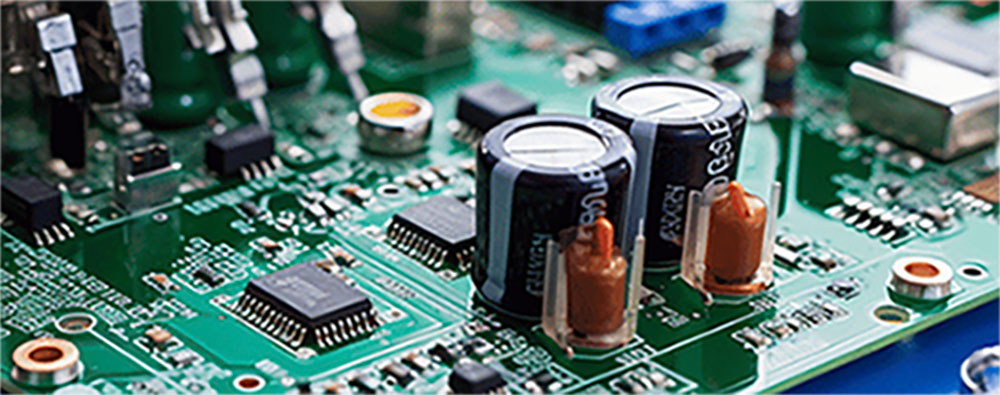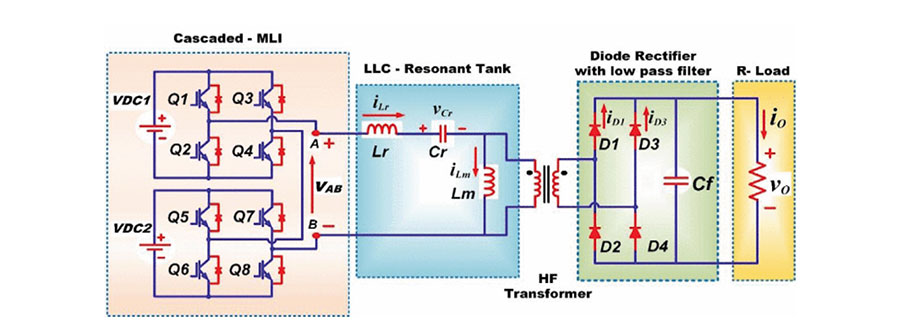DC-DC Resonant Converters: Advantages, Challenges, and Proposed Solutions

This article describes DC-DC resonant converters and their vital role in the green energy movement. It explores the applications of these converters, ranging from smart grids to electric vehicles and outlines the advantageous features such as high power density, superior efficiency, etc.
In the recent drive for green energy in power systems, DC-DC resonant converters (RC) have drawn significant industrial attention. They are widely employed in applications including smart grids, electric vehicles, and renewable energy systems (RES).
Are DC-DC resonant converters more advantageous than traditional converters?
These resonant converters have many advantageous features, like:
- Smooth waveforms
- High power density
- High efficiency
- Minimal EMI emissions
- Gentle switching at high frequencies
- Good isolation
DC-DC resonant converters usually have features that lower switching losses at the inverter switches and output rectifier diodes. This lets them work efficiently at higher switching frequencies.
Additionally, they greatly decrease the size of the parts, particularly the magnetic components of the system, like the power transformers and passive filters.
Soft switching guarantees that the converter experiences fewer switching losses even when it is working at a high switching frequency.
Due to their advantages over traditional converters in terms of efficiency and accuracy, resonant DC-DC converters are becoming more often used for power conversion in both high- and low-voltage applications.
Resonant converters' behavior can be categorized according to a variety of factors, such as their
- Frequency ratio
- Mode of operation
- Switching mechanism
A converter can achieve zero voltage switching (ZVS) commutation for all switches if it is able to achieve a switching frequency higher than the resonance frequency.
An alternate cause of zero current switching (ZCS) is a resonant frequency that is higher than the switching frequency (SF). Center-tapped or Full-bridge (FB) rectifiers are used on the secondary side of resonant converter designs, while primary-side inverters are used.
LLC Resonant Converters
One of the popular resonant topologies that is frequently used in a variety of applications is the LLC resonant converter. Resonant converters are made with inverters on the primary side and full-bridge (FB) or center-tapped rectifiers on the secondary side.
Advantages
Their advantageous characteristics outperform those of other RPC topologies.
- High power density
- Low EMI emissions
- Soft switching capability
- High efficiency
- Low switching losses
Throughout the whole operating range of the converter, the power switches can accomplish soft switching action, leading to very low switching losses and great efficiency. Whereas, in order to perform step-up and step-down operations with an extra-wide input voltage range, LLC RPC may rely on frequency control.
Challenges
This converter's performance has been verified for full bridge inverter topologies and with center-tapped rectifiers or full bridge rectifiers at the secondary sides.
Full-bridge LLC converters are well-established and sophisticated in many low- and medium-power applications, but they still face certain challenges in high-input voltage applications where the amount of current stress on the switching devices affects system efficiency and reliability.
The Concept of ‘Multi-Level Resonant DC-DC Converters’
It was suggested to use multi-level resonant DC-DC converters to meet the demands of high-voltage operation.
Advantages
Multilevel converters can achieve
- Produces a high-quality waveform with less harmonic distortion
- Reduces the voltage stress on the switching devices
- Low Electro-Magnetic Interference (EMI) output
- Low switching losses
- High power quality
- High efficiency
Another interesting feature of multilevel inverters is their simplicity in integrating with batteries, RES, capacitors, and plug-in electric vehicles.
By enabling the use of low-voltage-rated switches for high-voltage applications, multilevel converters can improve the switching qualities, availability, and affordability of the devices.
Resonant DC-DC converters and multilevel inverters can be used to create an efficient system that increases the potential of both converters. Research has demonstrated that using RCs in conjunction with three-level inverters can reduce voltage stress to 50% of the input voltage.
Challenges
As output power levels rise, the potential for switching device current ratings also increases. This can make switch selection a laborious procedure in high-power circumstances.
3-Phase LLC Resonant DC-DC Converter
Instead of lowering the voltage rating of switching devices even more, a 3-phase LLC resonant DC-DC converter has been suggested and studied in many research studies. It can maintain all the benefits of 3-phase converters and accomplish soft-switching for all switches.
Challenges
However, these converters have poor light-load efficiency and a limited gain range. The resonant tank parameters in three-phase LLC RCs are never quite the same for each phase, which suggests that each phase's gain characteristic is different from the others', aggravating the ripples in the output current.
Because of this, correcting the current imbalance necessitates using a bigger output capacitor; also, using three discrete transformers increases the volume and weight of the converter system. Therefore, using multilevel LLC resonant DC-DC converters instead of the current topologies may be a superior option.
Proposed Solutions
MLIs are used on the converter's input side to increase the power range of LLC RCs and lessen the voltage stress between the switching components, which makes them a desirable substitute for high-power and high-voltage applications.
Certain research has addressed the pairing of MLIs and LLC RCs. It can achieve ZVS and ZCS for the primary switches and rectifier diodes under a variety of load and input voltage conditions, respectively. The system can also minimize voltage stress.
It was shown the modular multilevel resonant (MMR) DC-DC converter, which has the best features of both the MMC and the LLC. On the other hand, the effect of switching frequencies on MMRC has not been investigated in detail in the current investigations.
An LLC resonant five level DC-DC converter was created for battery charging applications.
With the right control strategy, a cascaded five-level LLC resonant DC-DC step-up converter as shown in Fig. 1 was suggested. This method integrates a multilevel inverter and LLC RC's advantageous features into a single system. Because of its great power density and efficiency, this LLC resonant topology is used for isolated power conversion.
The use of a multilayer converter guarantees that the voltage stress is decreased across all switching components. Without the need for additional components, ZVS and ZCS for the switches and rectifier diodes were achieved throughout a broad input voltage and load range using a variable frequency control method.

Fig. 1 Schematic of the proposed cascaded 5-level LLC converter. Source: IEEE Access
The creation of a single converter with all the required features to generate efficient energy for all kinds of modern energy systems and other industrial applications is the main research challenge.
Summarizing the Key Points
- DC-DC resonant converters are widely used in green energy applications due to their high power density, efficiency, and minimal EMI emissions.
- Resonant converters can achieve soft switching, reducing switching losses and decreasing the size of magnetic components.
- Multi-level resonant DC-DC converters can improve the switching qualities, availability, and affordability of devices in high-voltage applications.
- Modular multilevel resonant DC-DC converters have the best features of both multilevel converters and LLC resonant converters.
- A cascaded five-level LLC resonant DC-DC step-up converter achieves soft switching and reduces voltage stress across all switching components.
Reference
Bughneda, Ali, Mohamed Salem, Eklas Hossain, Dahaman Ishak, and Natarajan Prabaharan. “Design Considerations and Performance Investigation of a Five-Level Cascaded Multilevel LLC Boost DC–DC Converter.” IEEE Access 11 (2023): 40441–56.
https://doi.org/10.1109/access.2023.3249229.